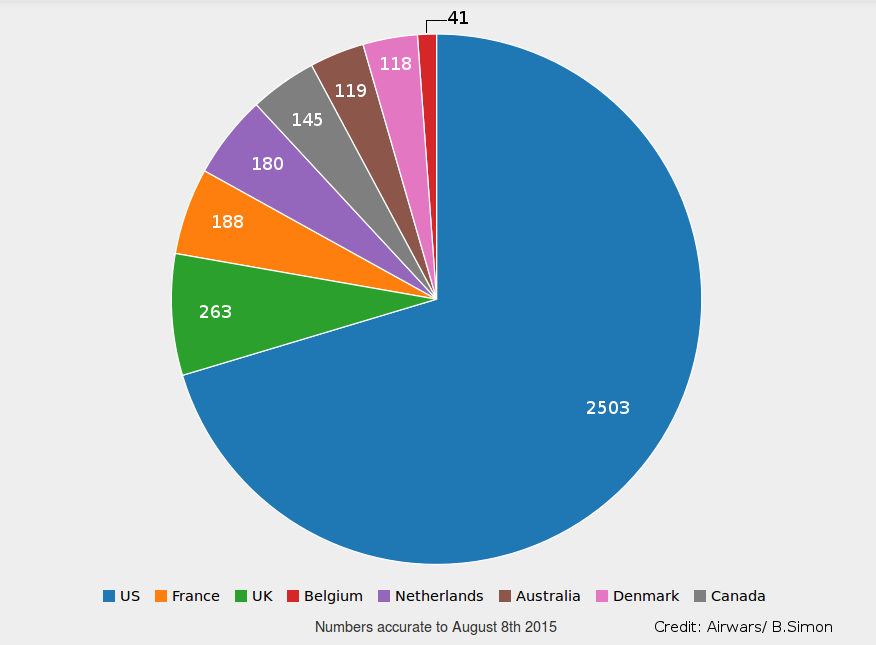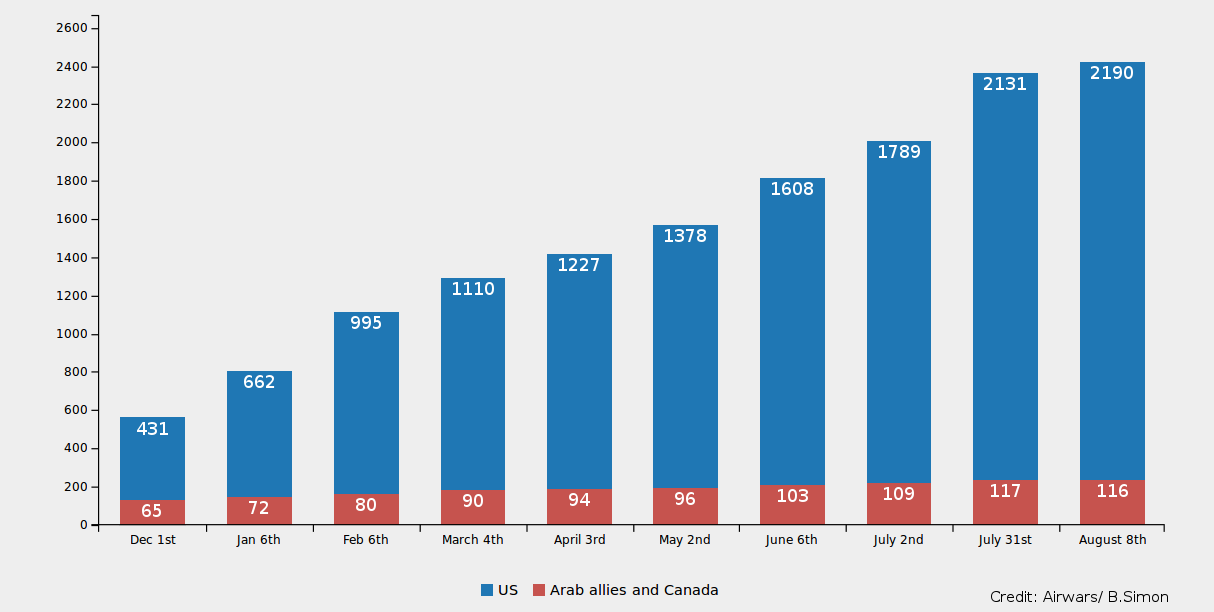IMAGE: An F/A-18 Super Hornet launches from USS Carl Vinson, October 2014 (US Navy/ Alex King)
At 1.45pm local time on August 8th 2014, the United States began airstrikes against Islamic State (Daesh), after the terror group had overrun much of northern Iraq and begun massacring non-Sunnis.
Six weeks later that air war was expanded to Syria, eventually drawing in eleven other partners which have also launched direct attacks on Daesh.
From the start, the team that would become Airwars has been tracking these Coalition strikes and outcomes. We’ve logged more than 1,000 military reports of airstrikes and targets, and maintain one of the most extensive public archive of the war available.
We’re also the only monitoring group to track reported civilian fatalities across both Iraq and Syria – and have so far identified claims of up to 1,250 civilians allegedly killed in Coalition airstrikes.
Here we present our own analysis of the first year of the Coalition’s air war against Daesh: what has been achieved, and at what cost to civilians.
5,975 airstrikes
As modeling by our data analyst Basile Simon shows, air attacks against Daesh continued to ramp up during the first year of operations, with 5,975 airstrikes recorded overall. In July 2015, Coalition aircraft launched an average of 27 strikes per day – more than five times the tempo of attacks almost a year earlier.
Having quit Iraq completely at the end of 2011, it took the United States some weeks to get its strike assets back into the region in August 2014. Erbil, the Mosul Dam and Mount Sinjar were the primary focus of these early airstrikes, as the US Air Force and Navy focused on areas most likely to fall to Daesh’s lightning advance.
On the orders of President Obama, on September 15th US airstrikes were expanded across all areas of Iraq threatened by Daesh. Iraq’s capital now began to experience airstrikes, with even Baghdad at risk of falling.
After 41 days of US-only airstrikes, France became the second nation to take on Daesh from the air on September 19th – attacking a logistics depot in north eastern Iraq.
It was four days later that the international Coalition was truly born, when five Arab nations joined the US in attacking Daesh in Syria. Combat aircraft from Saudi Arabia, Jordan, the United Arab Emirates and Bahrain all attacked on September 23rd, while Qatar provided support.
Iraq too saw a rapid expansion of international partners. British Tornados began airstrikes on September 30th, and were soon joined by aircraft from Belgium (October 5th), the Netherlands (October 7th), Australia (October 8th), Denmark on October 16th, and Canada on November 2nd.
Two different air wars
Although the Coalition battles Islamic State on both sides of an international border, the air war has evolved into two distinctly different fights.
Iraqi airstrikes remain almost exclusively a Western affair, with only Jordan among the Arab allies having carried out attacks on the territory of its near neighbour.
Those airstrikes support three different forces on the ground. To the north, Kurdish peshmerga are holding back Daesh across a 1,000km front. In central and western Iraq, Coalition strikes assist the Iraq Army and Shia militias which are attempting to drive back the terrorists.
It’s often a chaotic business. When Daesh captured Mosul in summer 2014, it seized the military hardware of two entire army divisions – including tanks, artillery, armoured personnel carriers and Humvees. So distinguishing between friend and enemy on the battlefield can be a challenge for aircrews.
Addressing the issue of ‘friendly fire’ incidents, Lt General John Hesterman of the Coalition recently noted that ‘There’s probably been a case or two, you know. Nobody’s perfect at this.’
Military officials refuse to say more – although research by Airwars has identified nine alleged ‘friendly fire’ events in the first year of strikes – which between them reportedly killed as many as 180 allied forces. All but one of these alleged incidents occurred in Iraq.
Three fifths of all Coalition bombings in the first year targeted Daesh in Iraq – some 3,664 airstrikes by our count. Historically that’s high – more than all the airstrikes carried out by international forces in Iraq between 2004 and 2011 combined, according to CENTCOM data.
Yet assessing the impact of these current airstrikes against Daesh remains challenging. Most advances by the terror group were halted, with some territory including Tikrit even recaptured.
However elsewhere Daesh has actually advanced, with the fall of Ramadi in May 2015 particularly alarming. And many of Iraq’s biggest cities remain in Islamic State hands – with millions of people under their sway. As a consequence most Coalition airstrikes are focused on these same urban centres – with clear risks to civilians on the ground.
Syria: an American campaign
While the early campaign in Syria saw action by half a dozen Coalition members, this has not been sustained. Today the United States is effectively conducting a unilateral air war against Daesh in Syria.
Every week since early December, the Coalition has provided Airwars with a breakdown of those airstrikes carried out by the US, and by its allies. This enables us to track how active America’s partners have been in Syria. The results are not encouraging.
Since December 1st, only 51 strikes were carried out in Syria by non-US aircraft. That compares with 1,759 American airstrikes targeting Daesh during the same period. For ten of those weeks, only US aircraft carried out Coalition strikes in Syria.
Canada’s Syrian engagement has so far had little impact on the campaign. In the four months since April, only four strikes have been carried out by Ottawa’s Super Hornets. Military leaders have described Canada’s operations in Syria as “a little bit more problematic” than those in Iraq – something British politicians may choose to bear in mind when they finally vote on whether to extend their own kinetic operations to Syria.
Of the 2,311 Coalition airstrikes in Syria during the first year of the campaign, many were focused on target sets which differed significantly from Iraq. A quarter of all Coalition attacks – 710 airstrikes – took place in just one location for example – the town of Kobane during Islamic State’s failed four month siege.
Other attackss were focused on destroying Daesh’s oil supply infrastructure, or on damaging its supply lines and border crossings. Only in recent months has the Coalition begun heavily targeting Syria’s ISIL-occupied towns. And it is here that we have seen most civilians reportedly killed.
Hundreds of civilians killed
All monitoring groups tracking civilian deaths in Iraq and Syria are in agreement that hundreds of non-combatants have so far been killed in Coalition airstrikes. Airwars shares that view.
Our first major report into alleged civilian fatalities was published in early August, achieving international impact. That study only ran to June 30th. We’re now able to provide estimates for the first full year of Coalition strikes.
To August 8th 2015 our Iraqi and Syrian researchers Latif Habib and Kinda Haddad have identified an overall total of between 986 and 1,251 claimed civilian fatalities, from 141 separate alleged incidents.
From among these, 68 incidents in particular are a cause for concern. On each occasion two or more credible sources reported civilian deaths – with Coalition airstrikes also confirmed in the near vicinity.

Omar Huwaidi Al Mueissat, 22, reported killed in Coalition strike at Ar Raqaa, July 18 2015 (via Raqaa is Being Slaughtered Silently)
Based on these events only, Airwars believes there is reasonable evidence to support claims of between 470 and 631 civilian non-combatants killed in the first year of Coalition airstrikes.
Many hundreds more civilian deaths have also been attributed to the Coalition – though at present we don’t have enough information to determine what took place.
In stark contrast, the international coalition has only conceded two “likely” deaths so far, both from a US airstrike in Harem Syria in early November 2014. CENTCOM says it’s also investigating six more incidents of concern.
One worry at Airwars is that reports of civilian deaths are actually rising. July saw the heaviest Coalition bombing yet of both Iraq and Syria, with 856 airstrikes during the month.
Claims of non-combatant deaths also peaked, with 22 incidents of concern flagged for July. Ten of these alleged events were in just one city, Ar Raqqa – Daesh’s putative capital and the target of 54 Coalition strikes during the month. In total, 22 civilians were reported killed in Coalition attacks on Ar Raqqa for July – thirteen of whom have so far been named.
As the Coalition’s campaign enters its second year, international airstrikes will increasingly focus on those Daesh-occupied towns and cities of Iraq and Syria which remain home to millions of non-combatants. Further civilian deaths are inevitable. Whether the 12-nation Coalition will be more forthcoming about such fatalities moving forward remains to be seen.



